When you’re considering the idea of cycling to work it’s easy to get stuck at the first theoretical steps before even riding for the first time. One of those questions is: what would be the perfect commuter bike? Should you get a road bike to be faster? Or should you get a fat bike so you don’t get stuck in the snow? Or anything else in between? But if it’s neither this nor that, will it be practical? … it’s a rabbit hole, really, and a perfect form of procrastination.
What’s the best kind of bike for commuting?
Hybrid bikes are the best type of commuter bikes for most people because of their versatility. The perfect commuter bike needs to be practical so you can carry everything you need, comfortable so you don’t have any aches when you use it, and durable, so maintenance doesn’t get into the way of commuting.
The perfect commuter bike for you is not the perfect commuter bike for someone else. The perfect commuter bike for you is the one that gets you excited to ride to work on a Monday morning.
Electric bikes built for everything and priced for everyone. Shop Rad Power Bikes, America's #1 electric bike brand. Get out. Go further. Ride Rad.
We’re going to structure this post around three key points:
- What to consider before choosing a commuter bike
- Different types of bikes and how good they are for commuting
- Extra features that make a bike an outstanding commuter
What to consider before choosing a bike
Terrain
Each bike type is designed for a specific terrain. The bike’s geometry, tire size and width, handlebar type, the presence or absence of suspension forks, gear range all work together in harmony. They all serve one end: to give you the most efficient riding experience for the terrain it’s meant to be used on.
For example, road bikes are great for paved roads, but they quickly fail on off-road segments. A good rule of thumb is to choose your bike based on the roughest terrain you need to ride on for a longer period.
Distance
Unless your commute is through the woods or on a very challenging terrain, you can ride 3 miles (5 km) or less on any bike. The longer your commute, the more thinking needs to go into choosing your bike.
Spending more than 15 minutes in the saddle can get uncomfortable. It can happen easily if your bike isn’t the right geometry and it isn’t perfectly dialled in for your needs.

Dress code
Think of how you intend to dress for your commute, and whether it’s practical. The more time you spend in the saddle and the more formal you dress for work, the less likely you can do it in your work clothes.
Riding 3-4 miles in the city on a dutch-style bike (a.k.a city bike) is perfectly doable in your work clothes, but riding 6 miles or more in a suit on a road bike will make you frustrated.
If you ride in your suit, you will probably look for a comfortable bike, something like a dutch-style bike, which you can ride in an upright position.
Things you need to carry
The two most common forms of carrying stuff are in a backpack or in a pannier. While neither is superior to the other, one of them is going to be more practical for your commute.

Backpacks can be practical if you have fewer things (maybe a pair of trousers and a shirt), but the more things you put in a backpack, the more it will make you sweat. If you have a laptop, some books and a change of clothes, panniers are a much more comfortable option, because they allow for ventilation on your back.
If you decide to use a pannier, you need to keep in mind that you will need a bike that comes with a bike rack or has mounting holes for a bike rack.
Weather
Rain can quickly ruin the most enjoyable of rides if you are not equipped with the right gear. Fenders (mudguards) keep the water off your back, legs and belly. They can turn an otherwise miserable commute into something enjoyable. They are a highly recommended addition to a commuter bike.
Riding experience and fitness level
Your riding experience and fitness level are completely individual to you and they change over time. The more you ride the fitter you get.
If you are new to bike commuting you should pick a bike that isn’t built primarily for speed, but rather something practical and comfortable. As you gain experience and want to go faster or explore various routes and types of terrains, you may find yourself looking for a more specific bike built for those special needs.
Different bike types as commuters
Road bikes – (built for speed)
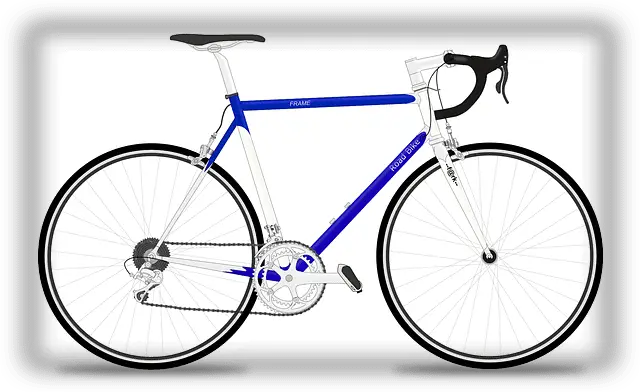
Road bikes are the fastest type of bikes. Everything about them is built for speed: geometry, wheels, weight.
Their geometry is designed so you sit in a forward-leaning, aerodynamic position. You need a strong core to avoid your hands getting numb from too much pressure.
Their wheels are narrow and slick (typically between 23 and 28mm), and they offer low rolling resistance. They are built with lighter components than most other bikes, because saving weight means being able to go faster, especially on a climb.
Road bikes have drop handlebars, which allow for several hand positions, making it easy to find the most comfortable and convenient grip even on longer rides. When going really fast, you can get in the drops and minimize your wind-resistance.
Because they are focused on speed, some comfort is sacrificed from a commuter’s perspective: they have no mounting holes for bike rack or fenders (mudguards), and their thin and narrow wheels don’t absorb bumps.
They feel most at home on paved roads at high speeds under experienced riders. In order to feel all the advantages of a road bike, you need to pedal at speeds higher than 15 mph (25 km/h).
Consider a road bike for your commute if you:
- Commute mostly on well maintained, paved roads
- Don’t need to carry too much stuff (you’re limited to a backpack)
- Are an experienced rider
- Commute in dry weather mostly
Flat bar road bikes or fitness bikes (built for speed and agility)
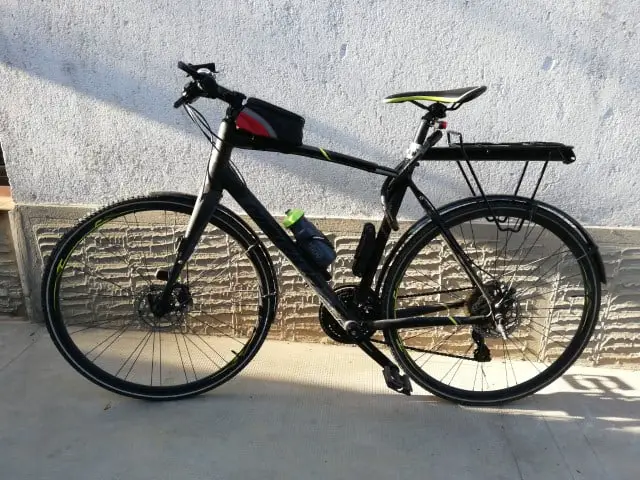
Similar or identical in geometry to road bikes, flat bar road bikes (a.k.a. Fitness bikes) are built for fast rides, mostly on paved roads, but they offer a little more comfort.
Because of the position and the geometry of the handlebar, you can sit in a less aggressive position. This allows you to keep an eye on the traffic better and it allows you to rely less on your core muscles.
Their wheels are slightly wider (typically between 25 and 32 mm), therefore they absorb bumps better than classic road bikes.
Many fitness bikes come with mounting points for fenders and bike racks. This is a welcome addition for commuters because it allows them to ride in wet weather and opens up the possibility of using panniers.
One downside of having a flat handlebar is that without adding a handlebar grip, it only allows for one hand position. This can make riding them on long distances somewhat inconvenient.
Flat bar road bikes are fast bikes that offer more versatility than road bikes. They are a good option even for new riders.
Consider a flat bar road bike for your commute if you:
- Have an urban commute that may include low quality paved roads
- Want to commute in all weather conditions
- Want to carry your stuff in panniers
Mountain bikes (built for off-road)
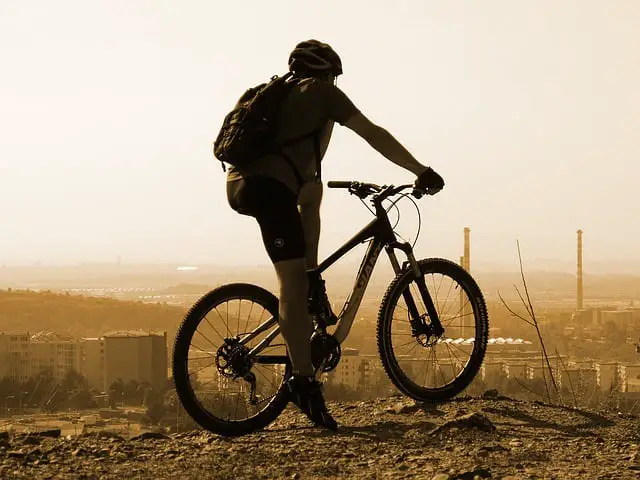
Mountain bikes (MTBs) are built to be ridden off-road on unpaved gravel roads and steep mountain hills.
MTBs have flat handlebars and offer an upright seating position. The rider feels completely in control of the bike.
They have wide and knobby tires, fork suspensions ( a.k.a. front shocks) and some of them even full suspension. This translates into a very smooth riding experience not only when riding in potholes, cobblestones, onto curbs but also riding off-road. Anywhere really.
The tires also offer good grip in snow and sand.
They have plenty of low gears. You can commute on a MTB even if you need to climb very steep hills.
Because mountain bikes are built for off-road riding, they lack some of the features that a typical commuter needs: mounting points for fenders and bike racks. Also, heavier wheels with knobs mean more rolling resistance. You have to pedal harder to maintain your speed.
Consider a MTB for your commute if you:
- Commute through the woods and off-road
- Don’t need to carry much stuff to work and don’t mind being limited to a backpack
- Don’t mind sacrificing some speed
- Already own a dedicated commuter bike and you want to spice up some of your rides
Touring bikes (built for long distances and heavy loads)

Built to carry heavy loads on long journeys, touring bikes strong and durable machines. To the untrained eye, they can appear as road bikes because of the drop handlebars. When inspected in more detail, it’s evident that they are not the same though.
Their geometry offers a more elevated riding position than road bikes. This makes it easier for the rider to keep an eye on the cars approaching from behind.
Touring bikes have multiple mounting points on the frame, and they often come equipped with fenders (mudguards) and a rear rack. These characteristics are essential for multi-day long-distance trips. It is very easy to put several large panniers on them.
They have wider tires than road bikes, which absorb bumps, resulting in a more comfortable ride.
Their downside is that they are heavier than road bikes. This, however, doesn’t make a big difference for most commuters, where the difference in marginally higher speeds are offset by traffic and weather conditions. In other words, you may be slightly faster on a road bike, but the speed difference really doesn’t matter as soon as you have to stop at a few red lights.
Consider a touring bike for your commute if you:
- Want multiple hand positions
- Have a medium to long-distance commute
- Don’t want to spend too much time on maintenance
- Want a bike that can carry a lot of stuff
- Want to commute in all weather conditions
Hybrid or trekking bikes (built as agile road and gravel riders)
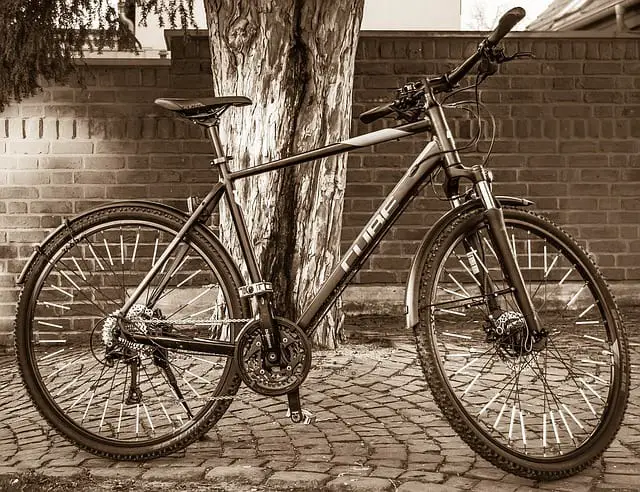
Hybrid bikes borrow some characteristics from touring bikes and some from mountain bikes and combine the best of both worlds in one.
Usually they come with riser bars that allow the rider to be in a more upright position. This makes them comfortable even on longer distances.
Their tires are usually slick or semi-slick, so they can travel fast on paved roads. They can also handle some gravel and light off-road thanks to their wider wheels and front suspension fork.
Hybrid bikes come in a wide variety of forms. Some come equipped with fenders and a rear rack, while others have mounting points only, so you can put on some as an option.
There are two potential downsides to hybrid bikes. Without an added handlebar grip, they offer only one hand position, and the front suspension can add some unnecessary weight to the bike while many urban commuters don’t see its benefits.
Consider a hybrid bike for your commute if you:
- Are looking for a comfortable bike and an upright riding position
- Commute on particularly bad urban roads or on gravel segments
- Want the option of carrying your stuff in panniers
- Don’t mind the extra few lbs of weight of the front suspension fork
Folding bikes (built to be practical)

The major advantage that folding bikes offer is that they are super practical, and can be easily stored.
Because they take up very little space, they can be easily stored in the office and they can also be brought onto public transport. This latter feature makes them excellent for multimodal commuting.
You can ride them to the station and take them with you on the train, tram, metro or bus. You have a quick way of getting around once you get off. It is a very convenient way of commuting in the city.
Most folding bikes are built with commuting in mind and come with fenders and a rear rack.
There are a few downsides to folding bikes. You’re somewhat limited in range because they are not built for long-distance rides, but rather for short and relatively flat ones. Their small wheels don’t offer as much riding comfort as their big brothers. Their gear range is also somewhat limited, making them adequate only for smaller hills, but not for steep climbs.
Consider a folding bike for your commute if you:
- Have either a short, city commute or combine cycling with public transport
- Have limited space to store your bike either at home or in the office
- Don’t mind riding at a slower pace
Gravel bikes (built for speed and comfort on rougher roads)

Gravel bikes combine the speed of road bikes with the ruggedness of mountain bikes. Their speed and durability make them a very appealing choice for commuters.
Gravel bikes come with a slightly more relaxed geometry than road bikes. They have a more tire clearance and wider tires, which translates to a smoother ride even on gravel roads or low-quality urban roads.
They have mounting points for fenders and racks. These are welcome options among commuters.
Almost all gravel bikes have powerful disc brakes. Disc brakes offer the rider the confidence that he can come to a full stop whenever he needs to, even when cruising at a high speed with heavy loads.
Gravel bikes come with drop handlebars, which offers multiple grips without having to add handlebar grips.
The downside of gravel bikes is that they are among the most expensive bikes. Since they are a relatively new breed of bikes, used ones are not easy to come by.
Consider a gravel bike for your commute if you:
- Have a medium or long commute
- Speed is important to you, but so is comfort
- Ride off-road or gravel road segments
- Want the option of panniers and fenders
- Don’t mind spending some extra money.
Cyclocross bikes (built for speed off-road)

A cyclocross bike is similar to a gravel bike because it’s the combination of a road bike with a mountain bike. They are built for short off-road races (a typical cyclocross race is max 1 hour long and is on a 1-2 mile circuit).
There are some differences that set cyclocross bikes apart from gravel bikes. Cyclocross bikes are built for races and lack some comfort features that gravel bikes have. They lack mounts for fenders and a rear rack, they often lack mounting holes for water bottles too.
Cyclocross bikes also have a different gearing range than gravel bikes, which makes it easy to climb steep hills, but they are not built to ride fast on flat paved roads.
Their geometry makes them perfect for taking sharp turns and maneuvering.
While cyclocross bikes are definitely fun to ride, if you are looking for a commuter, you may find a gravel bike better for the task. Gravel bikes are almost as capable off-road, but they are better equipped to be ridden to work.
Consider a cyclocross bike for your commute if you:
- Don’t mind sacrificing comfort and speed for the fun factor
- Don’t mind spending some extra money compared to other solid commuters
- Already own another bike and want to spice up your commute every now and then.
City bikes or Dutch style bikes (built for comfort and practicality)
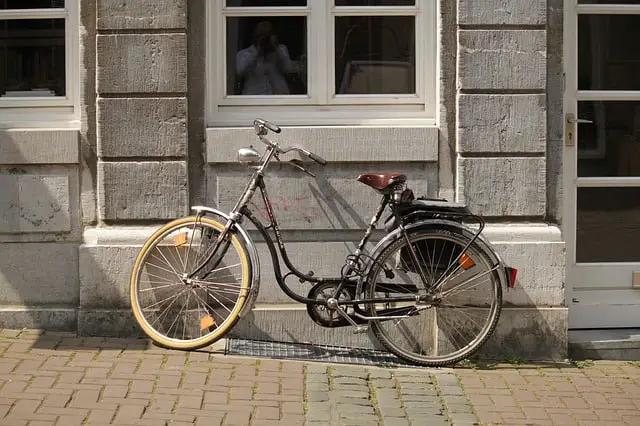
These are the classical looking bicycles most used as commuters in flat cities. They can be found in many cities that offer bikes for hire as part of their transportation system.
They are low maintenance, durable bikes and come with a number of comfort features, which make them ideal for city commuting.
City bikes come with fenders and racks, and they often come equipped with a handlebar basket too. There is plenty of storage aboard.
They offer a very comfortable upright sitting position, which is not very favorable from an aerodynamic point of view, but since they are built for shorter city rides, this is not an issue. They have swept-back handlebars and usually an internal gear hub of 3-8 gears. These gears make them adequate for moderate hills, but the gear range is quite narrow, so you will struggle on steep slopes.
They often come with added practical features such as a hub dynamo, so you don’t have to worry about lights and batteries.
They are easy to get on and off, and can be ridden in work clothes.
There are two downsides to city bikes. Their robust body and the added comfort comes at the price of a heavier weight. They are the heaviest of bikes, indeed. The second disadvantage is that it can be tricky to store them, especially overnight. Since they are built for city use, and most people living in cities live in apartments, either a good outdoor storage is necessary where you can lock them, or some bike room in the apartment block, since to carry them upstairs can be cumbersome.
Consider a city bike for your commute if you:
- Have a short city commute
- Want to commute in your work clothes
- Don’t want to ride fast
- Want a comfortable, understated commuter bike.
Fixies or single-speed bikes (built to be simple and fun)

Fixies and single speeds (especially fixies) are the purest form of riding a bike. They are the simplest of all bikes, which makes them very easy to maintain. You don’t need to worry about gears, disc brakes (some of them don’t even have brakes).
They are often used as commuter bikes in the city. They come in various forms. Some of them have drop handlebars, some come with flat bars or even bullhorn handlebars (a.k.a. Pursuit handlebars).
Fixies and single speed bikes are a lot of fun to ride, but they require a very specific type of rider. Since you are limited to one gear ratio, you may struggle to get up steep (or even moderate) hills, depending on your fitness level.
Most of these bikes are bare-bone bikes and don’t come with mounting points for fenders and a rear rack.
Consider a fixie or a single speed bike for your commute if you:
- Commute mostly on flat roads (or you are very fit)
- Don’t need to carry too much stuff to work
- Want a bike that requires the least amount of maintenance
- Don’t mind not being able to coast (on a fixie).
Electric bikes (built to help you when your legs need it)

If you need some extra kick on steeper hills or you need to carry children in a trailer or some heavy stuff on your commute, an electric bike can be of great help. It’s also a good help if you want to reduce how much you sweat.
Electric bikes come in a variety of forms ranging from folding bikes to MTBs to road bikes to trekking bikes. They provide some extra power when needed, but switching off the motor they ride as normal bikes.
Charging the battery is very cheap, and you can go anywhere between 20 and 120 miles (30 – 200 km) on a single charge. If you are looking for an electric bike for commuting, it’s worth checking out the distance you need to ride and measure it against its range.
There are two major downsides to electric bikes. Because of the battery and the electric motor there is a significant weight increase. This isn’t a problem when the motor is on (which is why people buy electric bikes in the first place), but carrying the extra weight with the motor off or with a flat battery, it becomes very noticeable. Electric bikes are also significantly more expensive than their only-human-powered counterparts.
Consider an electric bike for your commute if you:
- Have steep hills you find hard to climb
- Want to carry extra heavy stuff (here’s an article about pulling trailers uphills with an electric bike)
- You want to minimize sweating
- You see the extra cost as an investment in your health.
Fat bikes (built to excel on snow and sand)
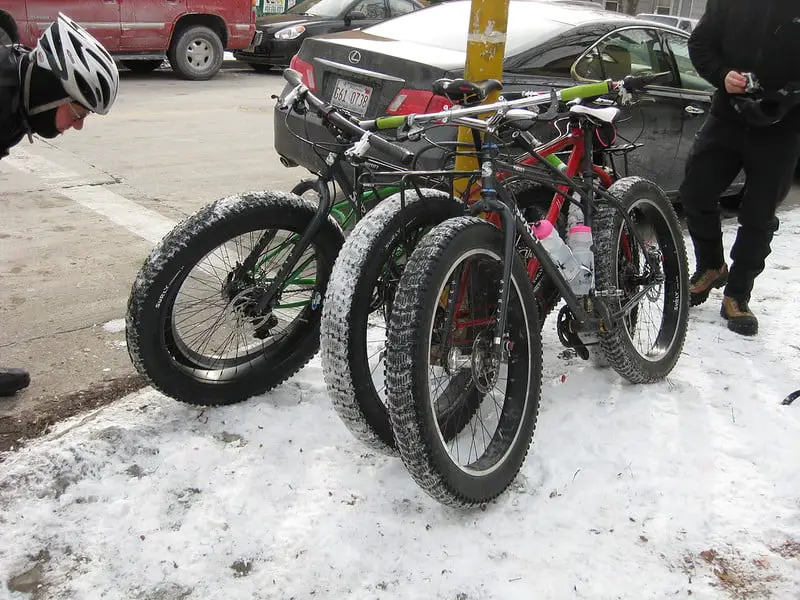
Similar in appearance to 90’s mountain bikes, fat bikes get their name from the size of their tires. They are built to be ridden on uneven grounds and where narrower tires would sink into the ground. They mostly shine on snow and loose sand.
They can be useful commuters, but only in very specific conditions, where no other bike will get you. Diehards can use them in heavy winter snowfall. If you have heavy winter snowfall that lasts for weeks or months, they may be a good second bike to keep. They can also be useful if there is a shortcut to your commute that takes you on a sandy terrain.
For most regular commuters they are an overkill, because the benefit they offer isn’t something a bike commuter needs.
Their major downside is their extra weight and the extra rolling resistance that comes from the sheer volume of the tires. This makes them very slow to ride, even when compared to mountain bikes.
Consider a fat bike for your commute if:
- You ride on snow or loose sand
- You don’t mind the extra weight and slow speeds
- You are looking for a second commuter bike to add some extra fun.
At a glance
| Distance | What terrain is it best for | Easy to climb hills | Rack mounting points | Practical to ride in work clothes | Speed | Practical commuter | Recommended for new riders | |
| Road bike | Long | Paved roads | Yes | No | No | Fast | No | No |
| Fitness bike | Medium – long | Paved, urban, light gravel | Yes | Yes | On short distances | Fast | Yes | Yes |
| Mountain bike | Short – medium | Off-road | Yes | No | No | Medium | No | No |
| Touring bike | Long | Paved, urban, light gravel | Yes | Yes | On short distances | Medium | Yes | Yes |
| Hybrid bike | Medium | Urban, gravel, singletrack | Yes | Yes | On short distances | Medium | Yes | Yes |
| Folding bike | Short | Paved city roads | No | Yes | Yes | Slow | Yes | Yes |
| Gravel bike | Long | Paved, urban, gravel | Yes | Yes | On short distances | Medium – fast | Yes | Yes |
| Cyclocross bike | Medium | Singletrack | Yes | No | No | Medium | No | No |
| City bike | Short – medium | Flat, paved city roads | No | Yes | Yes | Slow | Yes | Yes |
| Fixie or single speed | Medium | Flat, paved roads | No | Some | On short distances | Medium | Only in city | No |
| Electric bike | Medium – long | Hills or heavy loads | Yes | Some (depends on bike) | Yes | Fast | Yes | Yes |
| Fat bike | Short – medium | Snow and sand | No | Some | No | Slow | No | No |
From good to great
If want a dedicated commuter, there are a few features that can make a bike stand out from the crowd.
Internal gear hubs
Internal gear hubs (IGH) offer you the convenience of multiple speeds without multiple cogs on the rear wheel. The main advantage of IGHs is that unlike bikes with derailleurs, they don’t require any maintenance because it’s a closed system that prevents from grime, water or dust getting in it.
Belt drive
Water, snow and salt cause the chain to rust. A chain needs to be changed every year if used year round for commuting in all weather conditions. That is, if the chain is maintained (cleaned and lubed) regularly.
Belt drive bikes don’t have this issue, because the power is transmitted from the pedal to the wheel with a carbon belt. It requires no maintenance, it doesn’t rust and it operates much smoother and quieter than a bike chain. Also, belt drives have a much longer life-span, needing replacement only every 3-4 years.
Dynamo hub
Another convenience feature, which is a welcome addition to a commuter bike is a dynamo hub, which powers your front and rear lights without having to charge or replace the batteries.
The dynamo generates power while the front wheel is in motion. It is connected to the front and rear lights with wires. Often the rear light has a capacitor (a small battery), which keeps the light powered for a few minutes even after stopping. This comes in very handy when you stop at a red light in the night.
Bonus tip
I want to give you a final, bonus tip. If you’re new to bike commuting. I recommend you to start as soon as you can, but start on a bike that you already own or you can get your hands on. In the first few weeks you will learn a lot about your route, your body, the features you need in a bike. You may already own the perfect commuter bike for your commute. I have a course for beginner bike commuters, where I walk you through the first steps and help you start commuting.
Conclusion
What is the best commuter bike? It is the one that most efficiently and conveniently serves you on your commute. I hope that you have found the information useful, and you are one step closer to choosing the bike for your commute.
Happy Riding!
